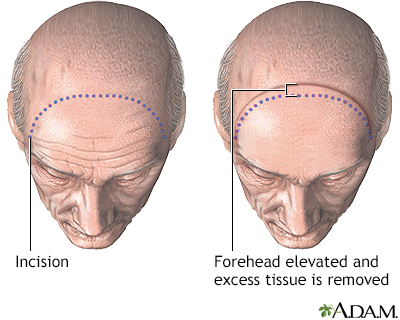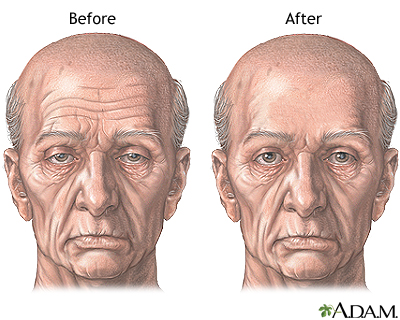Forehead lift
Endobrow lift; Open browlift; Temporal liftA forehead lift is a surgical procedure to correct sagging of the forehead skin, eyebrows, and upper eyelids. It may also improve the look of wrinkles in the forehead and between the eyes.
Description
A forehead lift removes or changes the muscles and skin that cause signs of aging as drooping eyebrows, "hooding" eyelids, forehead furrows, and frown lines.
The surgery may be done alone or with other procedures such as a facelift, eyelid surgery, or nose reshaping. The surgery can be done in a surgeon's office, an outpatient surgery center, or a hospital. It is usually done on an outpatient basis, without an overnight stay.
Facelift
A facelift is a surgical procedure to repair sagging, drooping, and wrinkled skin of the face and neck.

Nose reshaping
Rhinoplasty is surgery to repair or reshape the nose.

You will be given local anesthesia so that you will not feel pain. You might also get medicine to relax you. In some cases, general anesthesia will be used. During the procedure, you will feel some stretching of the forehead skin and possibly some discomfort. During the surgery:
Relax you
Conscious sedation is a combination of medicines to help you relax (a sedative) and to block pain (an anesthetic) during a medical or dental procedur...
Read Article Now Book Mark ArticleGeneral anesthesia
General anesthesia is treatment with certain medicines that puts you into a deep sleep so you do not feel pain during surgery. After you receive the...
Read Article Now Book Mark Article- Sections of hair will be held away from the surgery area. Hair right in front of the cut line may need to be trimmed, but large areas of hair will not be shaved.
- The surgeon will make a surgical cut (incision) at ear level. That cut will continue across the top of the forehead at the hairline so that the forehead does not look too high.
- If you are bald or balding, the surgeon may use a cut in the middle of the scalp to avoid a visible scar.
- Some surgeons will use several small cuts and perform the surgery using an endoscope (a long thin instrument that has a small camera on the end). Dissolvable implants may be used to hold the lifted skin in place.
Endoscope
An endoscope is a medical device with a light attached. It is used to look inside a body cavity or organ. The scope is inserted through a natural o...
Read Article Now Book Mark Article - After removing excess tissue, skin, and muscle, the surgeon will close the cut with stitches or staples. Before dressings are applied, your hair and face will be washed so the scalp skin does not get irritated.
Why the Procedure Is Performed
This procedure is most often done on people in their 40s to 60s to slow the effects of aging. It can also help people with inherited conditions, such as furrowed lines above the nose or a droopy eyebrow.
In younger people, a forehead lift can raise low eyebrows that give the face a sad look. The procedure can also be done in people whose brows are so low that they block the upper part of their field of vision.
A good candidate for a forehead lift has one or more of the following:
- Deep furrows between the eyes
- Horizontal wrinkles on the forehead
- Sagging brows
- Tissue that hangs down at the outer part of the eyelids
- Problem seeing because of the hanging tissue
Risks
Risks of anesthesia and surgery in general are:
- Reaction to medicines
- Breathing problems
Breathing problems
Breathing difficulty may involve:Difficult breathing Uncomfortable breathingFeeling like you are not getting enough air
 ImageRead Article Now Book Mark Article
ImageRead Article Now Book Mark Article - Bleeding, blood clots, infection
Bleeding
Bleeding is the loss of blood. Bleeding may be:Inside the body (internal)Outside the body (external)Bleeding may occur:Inside the body when blood le...
 ImageRead Article Now Book Mark Article
ImageRead Article Now Book Mark ArticleBlood clots
Blood clots are clumps that occur when blood hardens from a liquid to a solid. A blood clot that forms inside one of your veins or arteries is calle...
 ImageRead Article Now Book Mark Article
ImageRead Article Now Book Mark Article
Risks of forehead lift surgery include:
- A pocket of blood under the skin (hematoma) that may need to be drained surgically
- Damage to the nerves that control muscles of the face (this is usually temporary, but may be permanent)
- Wounds that do not heal well
- Pain that does not go away
- Asymmetry of the eyebrow
- Numbness or other changes in skin sensation
Numbness
Numbness and tingling are abnormal sensations that can occur anywhere in your body, but they are often felt in your fingers, hands, feet, arms, or le...
 ImageRead Article Now Book Mark Article
ImageRead Article Now Book Mark Article
Occasionally, forehead lifts will make it hard to raise the eyebrows or wrinkle the forehead on one or both sides. If this happens, you might need more surgery to make both sides even. If you have already had plastic surgery to lift your upper eyelids, a forehead lift may not be recommended because it could affect your ability to close your eyelids.
In most people, the cut for the forehead lift is under the hairline. If you have a high or receding hairline, you may be able to see a thin scar after surgery. You will need to style your hair so that it partly covers your forehead.
Receding hairline
Partial or complete loss of hair is called alopecia.

If the forehead skin is pulled too tightly or there is a lot of swelling, a wide scar may form. In some cases, hair loss may occur along the scar edges. This can be treated by surgically removing the scar tissue or areas of hair loss so a new scar can form. Permanent hair loss after a forehead lift is rare.
Swelling
Swelling is the enlargement of organs, skin, or other body parts. It is caused by a buildup of fluid in the tissues. The extra fluid can lead to a ...

Before the Procedure
Before your surgery, you will have a consultation. This will include a history, physical exam, and a psychological evaluation. You may want to bring someone (such as your spouse) with you during the visit.
Feel free to ask questions. Be sure you understand the answers to your questions. You must understand fully the preoperative preparations, the procedure itself, and the care after surgery.
Tell your surgeon or nurse if:
- You are or could be pregnant
- You are taking any medicines, including medicines, supplements, or herbs you bought without a prescription
During the week before your surgery:
- You may be asked to temporarily stop taking medicines that reduce the ability of your blood to clot. These medicines are called blood thinners. This includes over-the-counter medicines and supplements such as aspirin, ibuprofen (Advil, Motrin), naproxen (Aleve, Naprosyn), and vitamin E. Many prescription medicines are also blood thinners.
- Ask your surgeon which medicines you should still take on the day of surgery.
On the day of surgery:
- Follow instructions about when to stop eating and drinking.
- Take the medicines your surgeon told you to take with a small sip of water.
- Arrive at the hospital on time.
Be sure to follow any other specific instructions from your surgeon.
After the Procedure
The area is wrapped with a sterile padding and an elastic bandage to prevent bleeding and swelling (edema). You will feel numbness and temporary discomfort in the surgical site, which you can control with medicine.
You'll need to keep your head raised for 2 to 3 days after surgery to prevent swelling. Bruising and swelling will occur around the eyes and cheeks, but should begin to disappear in a few days or a week.
Bruising
A bruise is an area of skin discoloration. A bruise occurs when small blood vessels break and leak their contents into the soft tissue beneath the s...

As nerves regrow, numbness of the forehead and scalp will be replaced with itching or tingling. It may take up to 6 months for these sensations to fully disappear. The bandages will be removed a day or two after surgery. Within 10 to14 days, the stitches or clips will be removed in two stages.
Outlook (Prognosis)
You will be able to walk around in 1 to 2 days, but you will not be able to work for at least 7 days after surgery. You can shampoo and shower 2 days after surgery, or as soon as the bandages are removed.
Within 10 days, you should be able to go back to work or school. You should limit vigorous physical activity (jogging, bending, heavy housework, sex, or any activity that increases your blood pressure) for several weeks. Avoid contact sports for 6 to 8 weeks. Limit exposure to heat or sun for several months.
Hair shafts will be a bit thinner around the cut for a few weeks or months, but the hair should start to grow normally again. Hair will not grow in the line of the actual scar. Wearing your hair down on your forehead will hide most scars.
Most signs of the surgery should fade completely within 2 to 3 months. Makeup can cover minor swelling and bruising. At first, you'll probably feel tired and let down, but that will pass as you begin to look and feel better.
Most people are pleased with the results of a forehead lift. They appear much younger and more rested than they did before. The procedure reduces the look of aging for years. Even if you do not have the surgery repeated in later years, you will probably look better than if you had never had a forehead lift.
References
Niamtu J, Cuzalina A. Brow and forehead lift: form, function, and evaluation. In: Niamtu J, ed. Cosmetic Facial Surgery. 3rd ed. Philadelphia, PA: Elsevier; 2023:chap 4.
Saltz R, Anderson EW. Endoscopic brow lift. In: Rubin JP, Matarasso A, eds. Plastic Surgery: Volume 2: Aesthetic Surgery. 5th ed. Philadelphia, PA: Elsevier; 2024:chap 12.
Review Date: 12/31/2023
Reviewed By: Tang Ho, MD, Associate Professor, Division of Facial Plastic and Reconstructive Surgery, Department of Otolaryngology – Head and Neck Surgery, The University of Texas Medical School at Houston, Houston, TX. Also reviewed by David C. Dugdale, MD, Medical Director, Brenda Conaway, Editorial Director, and the A.D.A.M. Editorial team.







